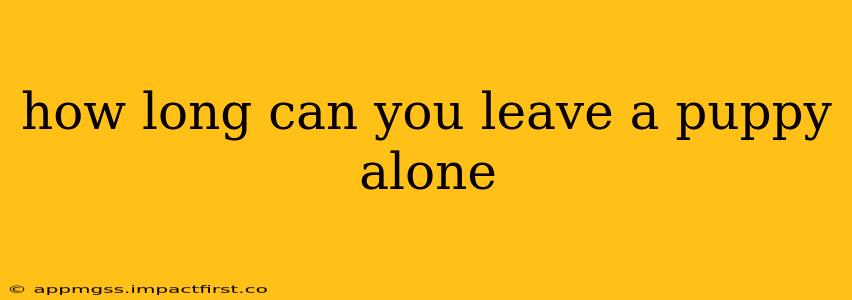How Long Can You Leave a Puppy Alone? A Comprehensive Guide
Leaving a puppy alone can be a stressful experience for both you and your furry friend. The amount of time a puppy can safely be left unsupervised depends heavily on several factors, including their age, breed, potty training progress, and overall temperament. Getting this wrong can lead to anxiety, destructive behavior, and accidents. Let's explore this crucial aspect of puppy ownership.
Understanding Puppy Needs:
Puppies, especially young ones, have incredibly small bladders and require frequent potty breaks. They also need regular attention for socialization, mental stimulation, and emotional well-being. Leaving a puppy alone for extended periods can lead to separation anxiety, destructive chewing, and accidents in the house.
How Long is Too Long? A Breakdown by Age:
The general rule of thumb is that a puppy's alone time should be no longer than one hour for every month of age, with a maximum of four hours at most, even for older puppies. For example:
- 8-week-old puppy: Maximum of 1-2 hours (due to needing frequent feeding and potty breaks).
- 3-month-old puppy: Maximum of 3 hours.
- 6-month-old puppy: Maximum of 4-6 hours (with proper crate training and preparation).
- 1-year-old puppy: Still requires several potty breaks and can handle longer periods alone. However, gradually increase their alone time and monitor for any signs of distress.
What Happens If You Leave a Puppy Alone For Too Long?
Leaving a puppy alone for excessive periods can have serious consequences:
- Accidents: Young puppies lack bladder control, resulting in frequent accidents if they're confined for too long.
- Destructive Behavior: Bored and lonely puppies may resort to chewing furniture, shoes, or other household items to relieve their stress and boredom.
- Separation Anxiety: Prolonged periods of alone time can lead to the development of separation anxiety, a condition characterized by excessive barking, whining, pacing, and destructive behavior when left alone.
- Health Problems: In extreme cases, prolonged isolation can impact a puppy's emotional and physical well-being.
How to Prepare Your Puppy for Alone Time:
- Crate Training: A crate provides a safe and secure space for your puppy when you're away. Introduce the crate positively with treats and toys.
- Potty Training: Consistent and frequent potty training is vital to prevent accidents.
- Mental Stimulation: Leave your puppy with puzzle toys or chew toys to keep them entertained.
- Gradual Desensitization: Start with short periods alone and gradually increase the duration as your puppy becomes more comfortable.
- Safe Environment: Puppy-proof your home to minimize the risk of accidents and destructive behavior.
Signs Your Puppy is Experiencing Separation Anxiety:
- Excessive Barking or Whining: Constant vocalizations while you're away is a strong indicator of separation anxiety.
- Destructive Chewing: Targeting specific items or areas near doors or windows could be a sign of anxiety.
- Elimination Problems: Increased accidents in the house, despite being house trained, suggests distress.
- Pacing or Restlessness: Visible signs of anxiety while you're preparing to leave or when you return.
What to Do If Your Puppy Shows Signs of Separation Anxiety:
If you notice any signs of separation anxiety, it's crucial to seek professional help. A veterinarian or certified dog trainer can help you develop a tailored plan to address the issue. There are many strategies that can help your puppy cope with your absence.
Remember, responsible puppy ownership involves careful planning and understanding your puppy's needs. By following these guidelines and prioritizing your puppy's well-being, you can ensure a happy and healthy transition into their new home.
